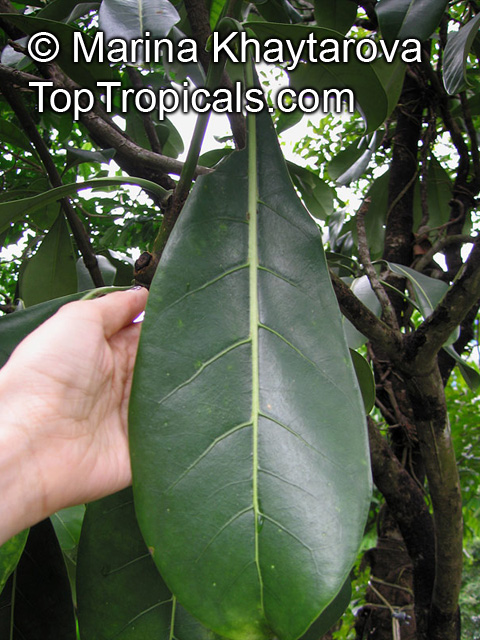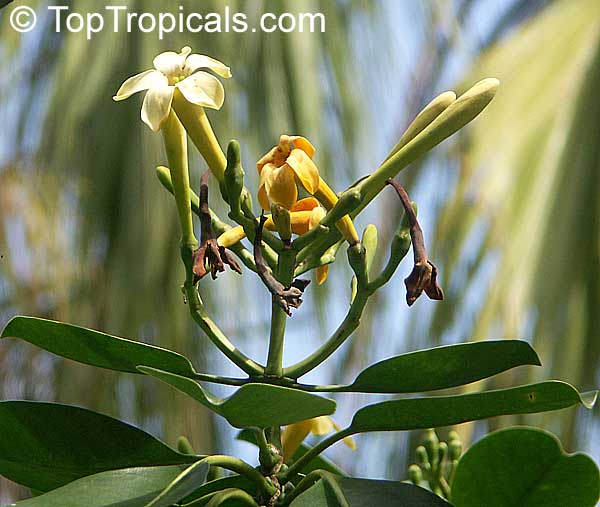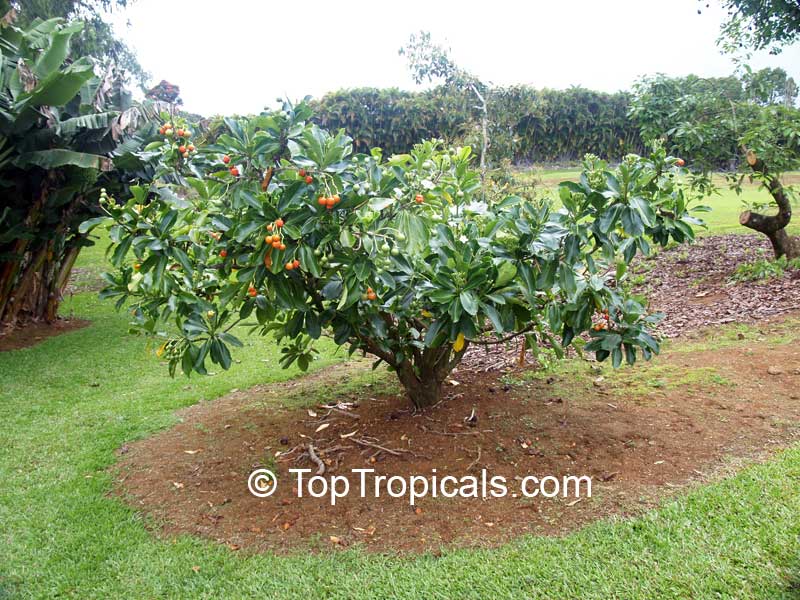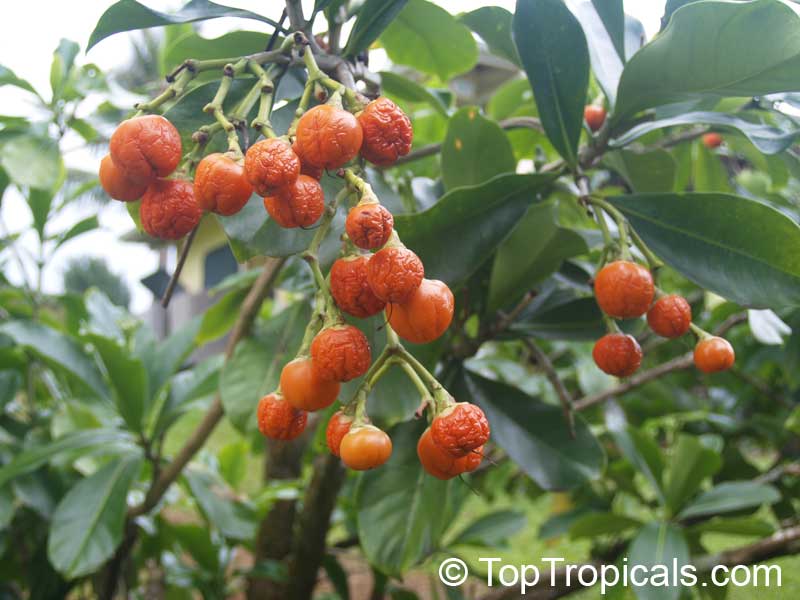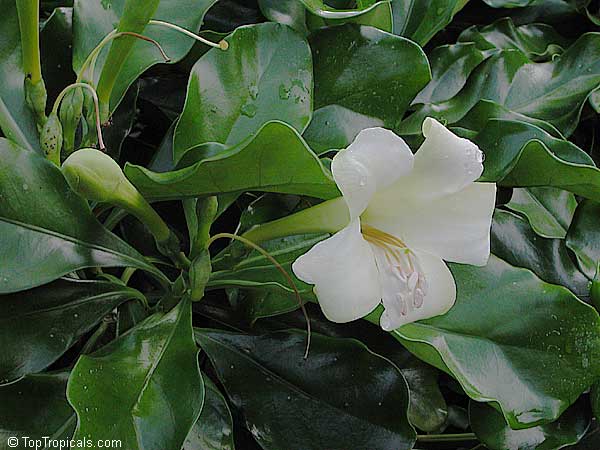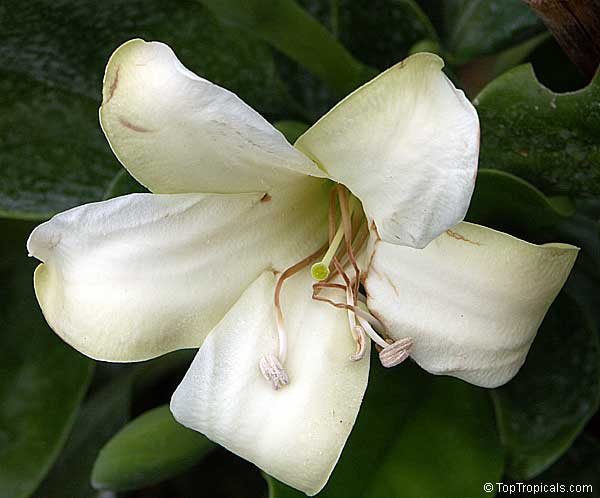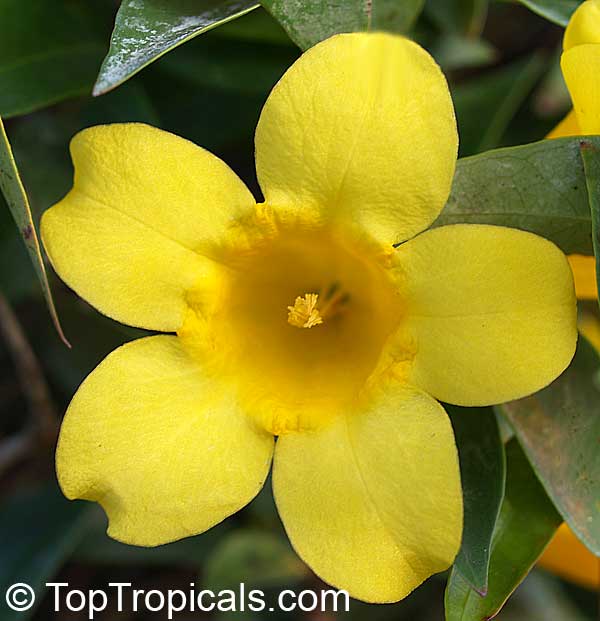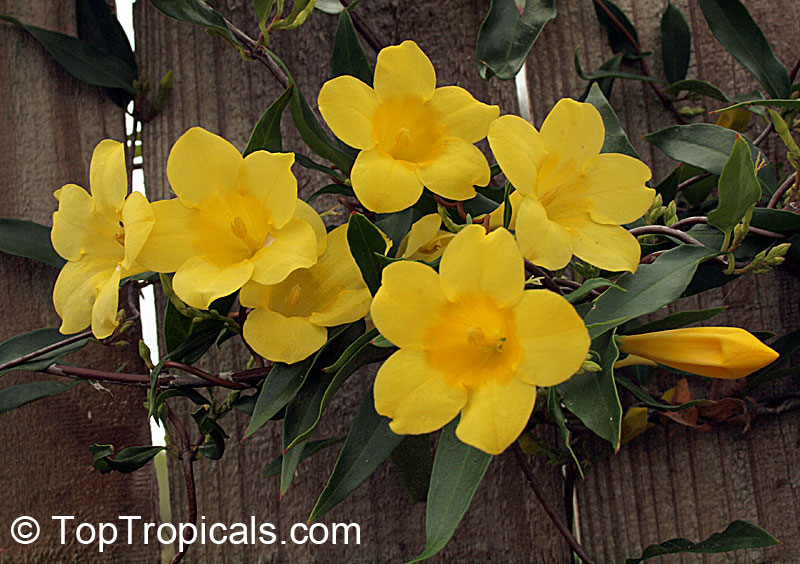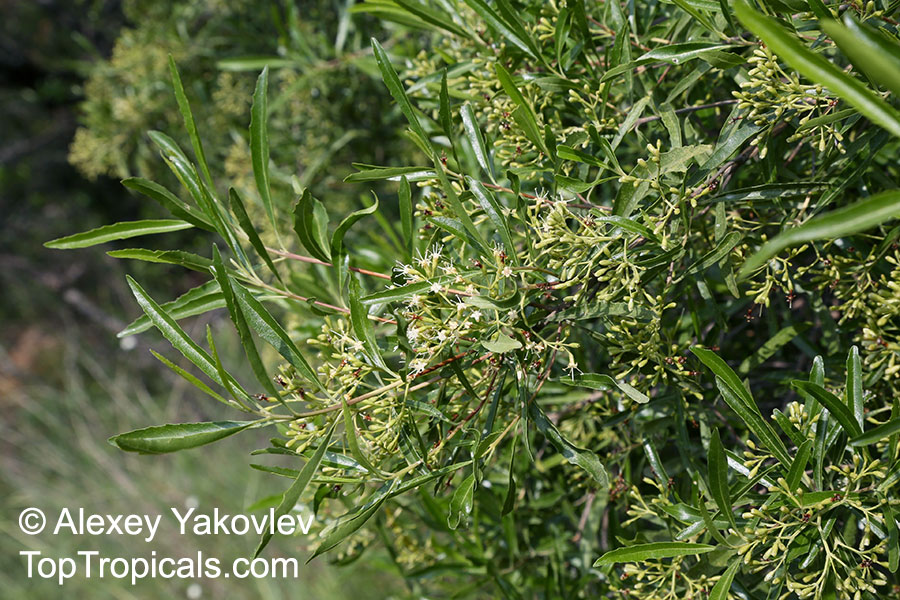Loganiaceae - Botanical Family
Top Tropicals Plant Encyclopedia
| Number of plants found: 13 | Next | 
|
Go to page: | 1 | 2 |
Botanical name: Desfontainia spinosa
Common name: Chilean False Holly
Family: Loganiaceae
Origin: Andes








Desfontainia spinosa is a large shrub, growing 5-10 feet tall and up to 5 feet wide. It can be grown in full sun to partially shaded places and requires moderate water for steady growth. It has a holly-like structure with ornamental foliage and thorns or spines. It produces bright red, crimson and vinous flowers from the end of spring to beginning of autumn.
In the Andes it has been used as an ethnomedical plant and employed in various treatments. It is well adapted to USDA hardiness zones 9-11 and grows best in areas that are frost-free. It also grows well in an area with good drainage and moderate sun exposure. In cold regions, it can be grown in a pot.
Growers should make sure to provide plenty of water for Desfontainea spinosa and plenty of fertilizer during the growing season. Water the plant slowly and deeply once or twice every week during the growing season. To improve drainage and aeration provide a soil mix that helps to retain moisture but is not water-logged. Feed plants with balanced, slow-release fertilizer once or twice a year in early spring and summer. For good foliage color, prune the shrub back lightly after flowering.
Botanical names: Fagraea auriculata, Fagraea borneensis, Fagraea bracteosa, Fagraea epiphytica, Fagraea javanica
Common name: Pelir Musang
Family: Gentianaceae (Formerly:Loganiaceae)
Origin: Southeast Asia







Fagraea auriculata is a large, tropical and subtropical shrub that is native to Southeast Asia. It can grow up to 5 to 10 ft tall and is usually found in semi-shade or full shade.
The Fagraea auriculata has fragrant, off-white or white flowers that typically bloom in spring and then again in the late summer. These showy flowers attract butterflies and hummingbirds, making this shrub a great addition to any garden.
When it comes to taking care of Fagraea auriculata, it prefers regular watering, depending on your local climate. It loves humidity, so if you live in a dry area you may need to water more often. Additionally, this shrub loves fertile soil, so adding organic matter to the soil will help your shrub thrive.
Fagraea auriculata can be grown in USDA zones 9-11. In colder regions, it can be grown in a large pot and brought indoors in the winter. Keeping your shrub in a pot will also allow you to move it if you need to. When bringing your shrub indoors during the winter, make sure to keep it away from any drafty windows and radiators. Place your shrub in a room with indirect, but bright, light and water regularly. Note that the plant may go dormant during the winter months.
Overall, Fagraea auriculata is a beautiful and easy to care for shrub that will bring color and life to your garden. With its showy, fragrant flowers and attractive foliage, it is sure to be a welcomed addition.
Botanical name: Fagraea berteriana
Common names: Perfume Flower Tree, Pua Keni Keni
Family: Gentianaceae (Formerly:Loganiaceae)
Origin: South Pacific









Specimen tree or shrub. Can be a large shrub or pruned to a small tree. Amazingly fragrant. All parts are poisonous. Grows into a small spreading tree or a large shrub; the branches quad-angular, with blunt tipped leaves and amazingly fragrant 3" tubular shaped flowers of creamy white which turn golden orange as the day longs. Flowers are popular for making Lei's. Pua Keni Keni in Hawaiian translation means "ten cent flower" which is what the flower once sold for. Sub-tropical to tropical growing conditions. Hardy to the high 40's. Toxic to animals.
According to other sources, belongs to Family Gentianaceae.
Botanical name: Fagraea ceilanica
Common names: Perfume Flower Tree, Pua Keni Keni, Trai Tichlan, Lau binh, Gia
Family: Gentianaceae (Formerly:Loganiaceae)








Fragrant creamy-white flowers of this small tree are up to 10 cm long, last for only a day, but fill the space around with delicate sweet scent. Can be grown as a small tree or compact bush in container. When planted in ground, will form a dense large shrub. Leaves are leathery and glossy, very pleasant to touch. Perfect exotic accent to a small yard or patio. The plant will tolerate some shade and can be successfully grown indoors. Blooms on and off year round. This plant is very rare and hard to find, propagation is not easy. Cuttings root very slowly, within 6-7 months. Toxic to animals.
Botanical names: Fagraea fragrans, Cyrtophyllum fragrans
Common names: Tembusu, Ironwood
Family: Gentianaceae (Formerly:Loganiaceae )
Origin: Burma to Indomalesia








The Tembusu is an evergreen tree native to Southeast Asia. It is slow-growing, medium-sized with a conical crown, sometimes being no more than a shrub. Very fragrant creamy white tubular flowers have a distinct aroma and the fruits of the tree are bitter tasting red berries, which are eaten by birds and fruit bats.
This is a highly variable species. The trunk of this tree can produce very hard wood that can be used to make chopping boards. The wood can last over 100 years, particularly as termites and weevils do not eat this kind of wood. People always use this wood for creating the floors of their homes and love to sleep on it. The tree yields a high-quality timber and excellent fuel and charcoal. It is planted in reforestation and soil stabilization programs and is also often planted as an ornamental and shade tree in parks and along roads.
Close related species:
F. gigantea - a large canopy tree with more regularly fissured bark and leaves that have an undulating margin and only 5 - 6 instead of around 8 pairs of secondary veins.
F. wallichiana - with broader leaves, larger flowers, and larger more ellipsoid fruits
Botanical name: Gelsemium sempervirens
Common names: Yellow Jessamine, Carolina Jasmine, Trumpet Flower
Family: Loganiaceae
Origin: Southeastern United States










Gelsemium sempervirens (Carolina jasmine) is native to the Southeastern United States and will thrive in full sun, semi-shade and requires moderate water to keep it looking its best. The blooms appear in yellow or orange clusters of fragrant flowers and typically appear in late winter or early spring and attracts butterflies and hummingbirds to the garden. Variety 'Plena' has double-flowers.
Carolina jasmine is suitable for growing in USDA zones 7 to 11. Hardy to 15 degrees F. If you are living in a colder region, you will need to provide it with extra protection by planting it in pots and bringing it indoors. In addition, ensure that you water the plant regularly, especially during periods of drought. Other than that, you will need to prune the plant after it has finished blooming for the season.
When it comes to caring for Gelsemium sempervirens it is important to remember that all parts of the plant are considered poisonous and should never be ingested. If any sap of the plant were to come in contact with the skin, it may cause irritation in sensitive individuals. As a result, extra care should be taken when growing this plant in areas with small children and pets.
Botanical names: Limahlania crenulata, Fagraea crenulata
Common names: Cabbage Tree, Malabera
Family: Gentianaceae (Formerly:Loganiaceae)
Origin: Malaysia







Botanical name: Nuxia floribunda
Common names: Forest Elder, Forest Nuxia, Wild Elder
Family: Loganiaceae
Origin: Tropical Africa








The sweetly scented, cream-white flowers are small in size, around 3 mm long, and are borne in large, branched inflorescences.
Botanical name: Spigelia marilandica
Common names: Indian Pink, Woodland Pinkroot
Family: Loganiaceae
Origin: North America









Native to North America, Spigelia marilandica is a small shrub that typically reaches a height of 2-5 feet, although the plant can reach heights of up to 8 feet in the wild. It is known for its red and crimson vinous flowers. The flowers fade to a yellow-orange color in the fall. This small shrub is a great addition to any garden and is also a great ethnomedical plant, as it is known to have various medicinal properties.
This plant loves full sun, but will also do well in semi-shade. It needs a regular amount of water and is hardy in USDA zones 9-11. When growing in a pot in cold regions, the soil should be kept evenly moist and the temperature should never drop below 55°F.
Spigelia marilandica is a great plant to have in the garden, as it is known to attract butterflies and hummingbirds. It can be grown from seed and will require minimal maintenance over the years. However, due to the presence of alkaloids and calcium oxalate crystals, the plant can be irritating when ingested and should be kept away from animals and children.
| Next |  |
Use link to repeat this search:
https://toptropicals.com/cgi-bin/garden_catalog/cat.cgi?search_op=and&keyword_op=and&language=e&family=Loganiaceae&number=10
&no_change_lang=1&user=tt&sale=1&first=0










